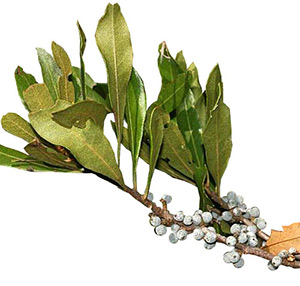

Scientific Name: Myrica cerifera
Family: Myricaceae (Bayberry Family)
Common name: Wax Myrtle
Description: Aromatic shrub or small tree to 25 tall; male and female flowers on separate plants; leaves coated with orange, resinous glands on both surfaces; flowers April; fruits August-October.
Range and Habitat: Grows in South Carolina in the sandhills, coastal plain, and maritime strand; common throughout in a wide variety of habitats.
In Porcher’s time… Wax myrtle was a powerful astringent, and a decoction was used to treat diarrhea, dysentery, uterine hemorrhage, dropsy after fever, and as a gargle in sore throat. It was also used to induce vomiting.
See the historical entry on this plant as it appears in Resources of the Southern Fields and Forests